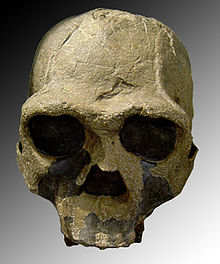KNM ER 3733
 | |
| Catalog no. | KNM ER 3733 |
|---|---|
| Species | Homo ergaster |
| Age | ~1.6 mya |
| Place discovered | Koobi Fora, Kenya |
| Date discovered | 1975 |
| Discovered by | Bernard Ngeneo |
KNM ER 3733[a] is a fossilized hominid cranium of the extinct hominid Homo ergaster, which is interchangeably referred to as Homo erectus. It was discovered in 1975 in Koobi Fora, Kenya, right next to Lake Turkana, by Bernard Ngeneo, a field worker for Richard Leakey.[1] Its geographic location is not to be confused with that of KNM WT 15000,[a] Turkana Boy, also known as Nariokotome Boy, who was also found near Lake Turkana nine years later in 1984.
KNM ER 3733 is one of the oldest Homo ergaster skulls in the world. Recent research using magnetostratigraphy has determined the age of KNM-ER 3733 to be about 1.6 million years old.[2]
KNM ER 3733 is a find of a near-complete cranium. Its brain size is about 850cc. KNM ER 3733 was compared to male fossils KNM ER 3833 and KNM WT 15000 (Turkana Boy), who were also found at the Koobi Fora site, and because of this, is said to be female. The features of KNM ER 3733 are less robust compared to the two male crania. It is considered an adult because of the extensive wear of its teeth, the fact that its third molars were present before the individual died, and because its cranial sutures were fully fused, which is only possible in adult specimen.[3]
See also
Notes
References
- ^ "Images of KNM ER 3733". Retrieved 2006-07-14.
- ^ Lepre, C. J.; Kent, D. V. (2010). "New magnetostratigraphy for the Olduvai Subchron in the Koobi Fora Formation, northwest Kenya, with implications for early Homo". Earth and Planetary Science Letters. 290 (3–4): 362. Bibcode:2010E&PSL.290..362L. doi:10.1016/j.epsl.2009.12.032.
- ^ "Knm-er." Academic Press Dictionary of Science and Technology. Oxford: Elsevier Science & Technology, 1992. Credo Reference. Web. 30 April 2014.
External links
 Media related to KNM ER 3733 at Wikimedia Commons
Media related to KNM ER 3733 at Wikimedia Commons- Archaeology Info
